Exploring the Mechanics of Water Distillation Devices
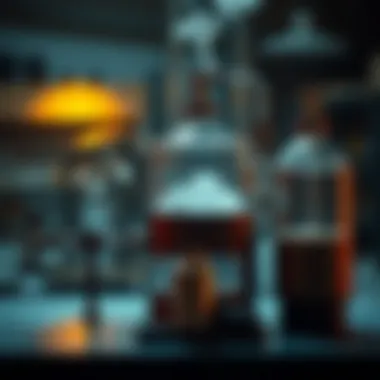

Intro
Water, a vital component for life, has been a focus of scientific exploration and innovation throughout history. At the heart of maintaining its purity lies the intricate process of distillation. Water distillation devices, though often overlooked, play a crucial role in ensuring that we have access to clean and safe water, whether for consumption, laboratory experiments, or industrial processes. This exploration provides an overview of how these devices work, their various applications, and the future of distillation technology. Understanding this equipment is essential for students, researchers, educators, and professionals who depend on reliable methods for water purification.
The mechanics of distillation revolve around the principle of separating components based on differences in boiling points. This principle has been applied in many settings, from small-scale home distillers to large industrial systems. The evolution of distillation technology has brought about a variety of devices that cater to specific needs, whether in personal use or scientific research.
In this article, we will further uncover the various types of distillation systems available today, explore their effectiveness, and weigh their advantages against their limitations. Notably, we'll reflect on potential advancements that may redefine the future of water distillation. By shedding light on these facets, our aim is to exhibit a comprehensive understanding of water distillation devices—an essential tool in the quest for clean water.
Preface to Water Distillation
Water distillation stands as a critical process in the field of water purification, offering significant benefits across various sectors. This method not only enhances the quality of water by separating contaminants but also provides a reliable solution for producing potable water in areas strained by resources. In a world facing increasing water scarcity and pollution, understanding the ins and outs of water distillation devices becomes ever more vital.
The basic principle behind distillation revolves around boiling water to create steam, which is then condensed back into liquid form, leaving behind impurities. This straightforward yet effective mechanism has paved the way for several applications ranging from household systems to large-scale industrial setups. With the growing emphasis on health and sustainability, the relevance of distillation devices cannot be overstated.
In this section, we will explore the essence of water distillation, defined clearly and precisely, laying the groundwork for the comprehensive discourse ahead. It’s important to appreciate the historical context as well, paving the way for modern innovations and the evolution of techniques used in water purification.
Definition of Water Distillation
Water distillation is the process of separating water from its impurities through boiling and condensation. In essence, the device heats water until it transforms into vapor. Since impurities, like salts and other contaminants, do not evaporate at the same temperature as water, they remain in the boiling chamber. Once the steam rises, it is channeled through a cooling apparatus where it condenses back into liquid. The result is distilled water, devoid of many dissolved minerals and contaminants.
History of Distillation Techniques
The roots of water distillation can be traced back to ancient civilizations. Archeological evidence suggests that the Babylonians and Egyptians had rudimentary methods for distilling water, which laid foundations for chemical processes that would evolve over millennia. By the time of the Roman Empire, a more refined technique had emerged, often putting the method to use for both drinking water and the production of essential oils.
Fast forward to the 8th century, and the advancements made in the Arabic world further developed distillation technology. Alchemists refined the art, creating sophisticated apparatus that would later be a precursor to modern distillation devices.
The Industrial Revolution marked a turning point, thanks to the advent of steam engines, which allowed for more extensive and efficient distillation processes. Today, technology has honed these methods, leading to sophisticated devices that serve myriad functions, from laboratory research applications to everyday domestic use.
Principles of Distillation
The principles of distillation are foundational to understanding how water distillers operate. These concepts lay the groundwork not only for the mechanics of the devices but also for the outcomes they produce in various applications. At its core, distillation leverages the differences in boiling points and vaporization characteristics of liquids to separate substances or purify water. Grasping these essentials is crucial for anyone involved in scientific research, manufacturing, or even everyday health and safety regarding drinking water. With this knowledge, users can make informed decisions about which distillation method or device best meets their needs.
Fundamental Concepts
Boiling Point
The boiling point of a liquid serves as a primary factor in distillation. It indicates the temperature at which a liquid turns into vapor. This characteristic is pivotal because it allows for the separation of components based on their specific boiling points. For instance, pure water boils at 100 degrees Celsius, but impurities—like dissolved salts—have different boiling characteristics. Thus, when water is heated, the impurities typically remain in the distillation flask, while vapor rises and condenses elsewhere.
The unique aspect of boiling points is their variability with pressure. In standard atmospheric conditions, they are fixed; however, under different pressure settings, such as in vacuum distillation, boiling points can lower significantly. This feature can improve the efficiency and effectiveness of the distillation process, making boiling point manipulation an advantageous aspect in both laboratory and industrial settings.
Vaporization
Vaporization is the next step in the process, essential for effective distillation. When a liquid surpasses its boiling point, it transitions into a gas—this is vaporization. This stage is where the magic begins. As water vapor rises, it leaves behind most of the impurities and sediments. The key characteristic of vaporization is that it’s not just about reaching a temperature; it’s about achieving a state change that effectively purges undesired chemicals or particles from the liquid.
This unique feature provides a significant benefit for water purification—since vaporization separates water from non-volatile contaminants, it's a powerful method for ensuring high purity levels. However, one must consider the energy inputs necessary to achieve this phase. Depending on the scale and efficiency of the device, energy consumption can be a downside to this process.
Condensation
Once vaporization has occurred, condensation is the subsequent critical step in the distillation process. During condensation, vapor cools down and transforms back into liquid. This transition is what returns water to a usable state, typically collected in a separate container for consumption or further use. One of the main characteristics that makes condensation indispensable is its ability to ensure that the purified liquid does not come into contact with the still’s residue, which contains impurities.
Each of these stages—boiling, vaporization, and condensation—works in harmony to facilitate the effective purification of water. That said, managing the condensation phase's conditions—such as temperature and surface area—can influence the overall efficiency of the distillation process. An issue could be associated with insufficient condensation, leading to less purified output, making the control of this process quite significant.
Types of Distillation Processes
Simple Distillation
Simple distillation is perhaps the most straightforward form of distillation. It involves the heating of a liquid to form vapor and subsequent cooling to return the vapor to liquid. This method is generally suitable for separating solvents from non-volatile solutes. Its primary advantage lies in its simplicity and the ease of setup, making it a go-to for basic purification tasks. One limitation, however, is its ineffectiveness for separating mixtures with close boiling points.
Fractional Distillation
Fractional distillation brings a level of sophistication to the distillation process. It employs a fractionating column, which allows the separation of multiple components simultaneously based on their boiling points. This method is particularly useful when dealing with complex mixtures, such as those found in crude oil refining. A major advantage is its ability to yield higher purity products across different components. The downside is that it requires more equipment and energy, which can lead to increased operating costs.
Steam Distillation
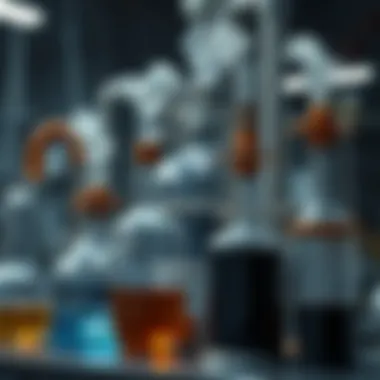
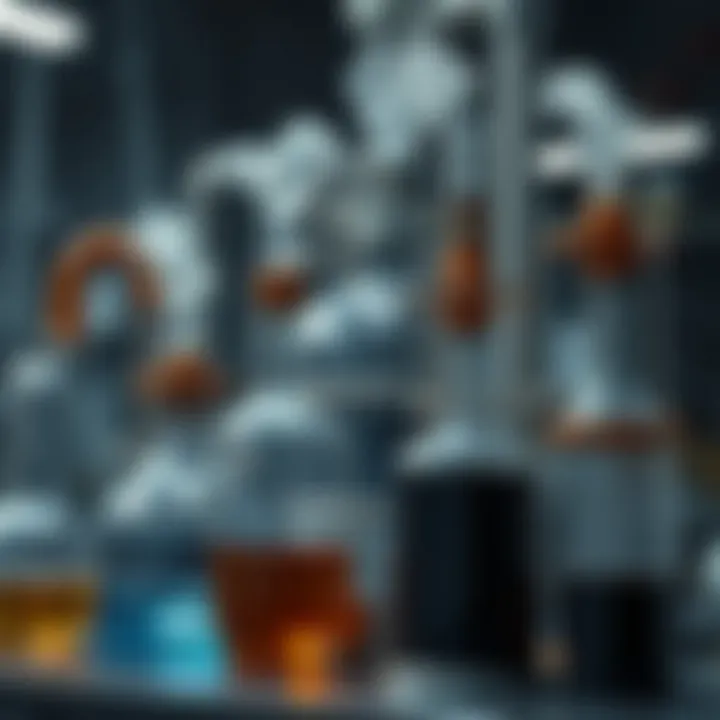
Steam distillation offers a unique approach to separating heat-sensitive substances, particularly in essential oil extraction. This method utilizes steam to vaporize the target compounds without requiring high temperatures that could degrade them. Its primary strength is in the gentle handling of the product, preserving quality during extraction. However, one downside is that steam distillation may not be as effective for purifying water heavily laden with soluble impurities.
The understandind of these distillation processes is vital for determining efficiency, purity, and applicability of water distillation devices across fields.
Types of Distillation Devices
Understanding various types of distillation devices is essential because they cater to different needs and applications, ranging from academic research to everyday household uses. Each type of distillation device is designed with specific functions, advantages, and considerations in mind. This diversity ensures that water distillation can meet varying levels of purity and efficiency, making it a key element in both scientific and practical water purification contexts.
Laboratory Distillation Units
Laboratory distillation units are specialized equipment designed for precision and control. These units are vital in research settings where high purity is essential, such as in chemical synthesis or analysis. Typically, they are composed of various parts including a heating mantle, distillation flask, condenser, and receiving flask. Each component serves a distinct purpose that contributes to the efficacy of the distillation process.
One common setup in laboratories is the use of a rotary evaporator, which uses low pressure and a rotating flask to gently evaporate solvents. This method reduces the likelihood of sample degradation, making it a preferred choice among chemists. The compact design and efficiency of these units lead to significant time saved during sample preparation.
When selecting a laboratory distillation unit, consider factors such as the boiling point of the substances being distilled, the need for solvent recovery, and the scale of operation. Also, advances in automation have made it possible to achieve greater precision and reduced human error.
Household Water Distillers
Household water distillers cater to the everyday consumer looking to purify drinking water. Easy to use and often compact, these devices can be a game-changer in ensuring the safety and quality of water consumed at home. Most models operate through a straightforward process: heating water until it vaporizes, followed by a cooling phase where the vapor condenses back to liquid form.
Besides removing impurities, household distillers can effectively eliminate unwanted tastes and odors, making water more palatable. They often include built-in filters and various features, such as automatic shut-off functions and storage tanks, which add convenience.
However, consumers should be aware of the energy consumption associated with these devices. While the initial investment may seem nominal compared to bottled water, the long-term operational costs should not be underestimated. Special attention should also be given to the maintenance of these units to ensure they operate efficiently and effectively.
Industrial Distillation Systems
On a different scale, industrial distillation systems are robust setups designed for high-volume applications across various sectors, including food processing, petrochemicals, and pharmaceuticals. These systems can utilize advanced techniques such as fractional distillation, which allows the separation of multiple components based on their boiling points. This method significantly increases the efficiency of solvent extraction and purification processes.
An industrial system may feature large-scale columns equipped with trays or packing materials designed to promote efficient vapor-liquid contact. Companies integrating these systems focus not only on the purity of the distillate but also on the sustainability of the process. Using heat exchangers and other innovative technologies can minimize energy consumption and environmental impact.
Implementing an industrial distillation system is a considerable investment, necessitating careful planning and design to align with production goals and regulatory requirements. Companies should assess their needs, including the types of substances to be distilled and the intended purity levels, to select the most suitable system.
"The choice of distillation device can significantly influence both the quality of the product and the operational efficiency in any distillation application."
In summary, whether in a laboratory, at home, or in an industrial setting, understanding the types of distillation devices allows stakeholders to maximize their water purification goals. Each type has its advantages and limitations that must be carefully considered to achieve the best results.
Applications of Water Distillation
Water distillation serves a pivotal role across various fields, acting as a cornerstone in many processes where water purity is essential. The benefits of using distillation are manifold: it effectively removes impurities, enhances the quality of water, and provides practical solutions in numerous applications. This section will explore how water distillation is employed in scientific research, drinking water purification, and pharmaceutical manufacturing, providing a thorough understanding of its importance in these areas.
In Scientific Research
In the realm of scientific investigation, water quality must be beyond reproach. Many experiments depend on a pure water source to ensure accurate results. Water distillation meets this need quite effectively.
Researchers rely on distilled water to create chemical solutions, conduct experiments in biology, and even in areas such as physics. By using water distillation devices, scientists can obtain O free from contaminants that could interfere with their experiments.
- Clarity of Results: The purity of the distilled water contributes directly to the clarity of experimental findings.
- Consistency: A distilled water source offers consistent composition across different batches, essential for reproducibility.
- Applications in Diverse Fields: From environmental studies to drug formulations, the implications are immense, underscores the versatility of distilled water in research.
In Drinking Water Purification
Amidst rising concerns over water quality, distillation emerges as a formidable method for purifying drinking water. This process not only provides safe hydration but tackles various contaminants effectively, such as salts, heavy metals, and microorganisms. Utilizing water distillation at a domestic level can address concerns about tap water safety.
Benefits include:
- Effective Removal of Contaminants: Distillation can effectively eliminate bacteria and other pathogens that can lead to illness.
- Improved Taste and Odor: Distillation can significantly improve the taste of water, making it more palatable for everyday use.
- Environmental Considerations: Using energy-efficient, modern distillation devices may lead to lower carbon footprints compared to traditional water purification methods.
In Pharmaceutical Manufacturing
The pharmaceutical industry is another sphere where distilled water is crucial. Laboratories must adhere to stringent regulations regarding water quality, so distilled water is often used in the production of medications and vaccines. This adherence ensures the safety and efficacy of pharmaceutical products.
Key factors include:
- Meeting Regulatory Standards: Distilled water meets the high standards required by agencies like the FDA, making it indispensable for anything that enters the human body.
- Minimal Risk of Contamination: By minimizing variables, the risk of contamination during the manufacturing processes is significantly reduced.
- Formulation Flexibility: Distillation allows for flexibility in formulations, as high-quality water can be tailored to meet specific needs of different drug compounds.
In summary, the applications of water distillation are foundational in scientific research, essential in drinking water purification, and critical in pharmaceutical manufacturing. Its ability to provide high purity levels, consistency in results, and compliance with regulatory benchmarks is what makes water distillation an invaluable process across various domains.
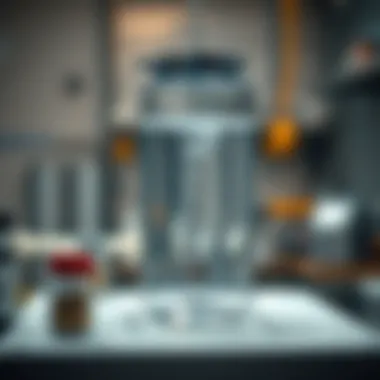
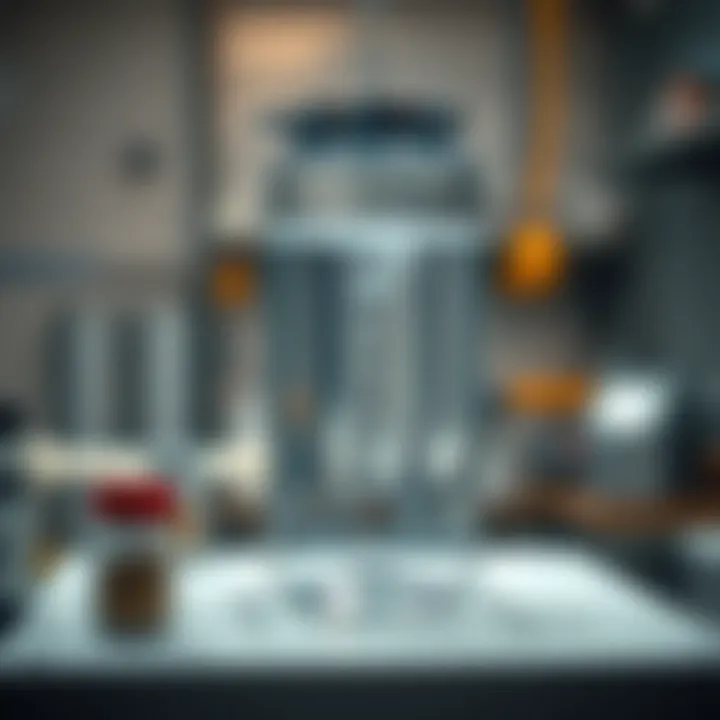
Advantages of Using Distillation Devices
Water distillation devices stand out in the realm of purification methods, offering several compelling advantages that cater to diverse needs and applications. From ensuring high standards of water purity to providing flexibility across various operational environments, distillation devices serve as a cornerstone for anyone looking to guarantee the quality of their water. Below, we delve deeply into these benefits, illustrating why such devices play a vital role in today’s technology-driven society.
High Purity Levels
When it comes to purifying water, nothing quite matches the high purity levels achieved through distillation. This process allows for the separation of water from impurities, including salts, microorganisms, and various contaminants. Given how crucial clean water is for health and safety, this aspect cannot be understated.
In a distillation system, water is heated to its boiling point, and the steam is collected and condensed back into liquid, leaving a majority of impurities behind. This two-step process effectively eliminates:
- Dissolved minerals that can alter taste and quality.
- Microbial pathogens, which are detrimental to health.
- Volatile organic compounds that can be toxic.
Essentially, the output is water that is nearly as pure as the one obtained from distillation in laboratory settings. The precise control of boiling rates and condensation ensures that the end product meets high standards necessary for both home and industrial applications.
Versatility in Applications
One of the great things about distillation devices is their versatility in applications. They find use in a myriad of fields which is no mere coincidence; their adaptability makes them suitable for different environments. For instance, in a laboratory setting, these devices can be crucial for preparing reagents and solutions. Meanwhile, at home, a simple countertop distillation unit can provide clean drinking water, free of impurities.
Beyond these environments, distillation systems are also essential in sectors like:
- Pharmaceutical manufacturing, where pure solvents and reagents are indispensable.
- Food and beverage processing, where the quality of ingredients directly impacts the final product.
- Seawater desalination plants, where distillation plays a key role in making seawater drinkable.
This variety of uses underscores a fundamental aspect of distillation technologies: you can adapt them to fit your specific needs. Whether for research, health, or industry, there’s a place for these devices everywhere.
Ease of Operation
Operating a distillation device typically comes with user-friendly features, making the process less cumbersome. With basic training and understanding, individuals can run distillation systems, whether they're in laboratories, industrial settings, or at home. This user-friendliness is crucial, particularly when considering the varied audience, from seasoned professionals to casual home users.
Many modern distillation devices integrate automated controls to further streamline operations. These features can include:
- Temperature regulation, ensuring that the boiling point is consistently maintained.
- Automatic shut-off mechanisms designed for safety and efficiency.
- Digital displays that simplify monitoring processes and outputs.
Such advancements mean that you don’t need to be an engineer to effectively utilize these systems. Anyone can harness the power of distilled water for their needs, without getting bogged down by complex procedures or excessive technical knowledge.
"The advantages of distillation go beyond just purification; they provide a flexible and efficient solution in various contexts, making clean water accessible to many" - is a statement that encapsulates the core value of these devices.
In summary, the merits of using distillation devices are clear. From providing unparalleled purity to being flexible and easy to operate, these devices cater to a wide spectrum of needs, making them indispensable in our quest for clean, safe water.
Limitations of Distillation Devices
While water distillation offers numerous benefits, it's essential to recognize that it isn't without its drawbacks. Understanding these limitations can provide clearer insights into the practicality and efficiency of distillation devices. Each hinderance carries weight when assessing whether distillation is the best method for a given application. Below, we explore some crucial factors that affect the performance and utility of distillation devices.
Energy Consumption
One of the foremost concerns with distillation devices is their energy consumption. The process of heating water to its boiling point requires a significant amount of energy, which can lead to higher utility bills, especially for larger units that operate continuously. Depending on the type of energy source used—be it electricity, gas, or another—this aspect can impact both the environmental footprint and operational costs.
In specific scenarios, like in remote areas where energy sources are limited or expensive, the cost associated with running distillation equipment could outweigh the benefits. Moreover, with the growing emphasis on sustainability and green technologies, the reliance on energy-intensive processes like distillation raises questions about long-term feasibility.
Time and Efficiency Factors
Time and efficiency are also pivotal considerations when evaluating distillation devices. While these systems can purify water effectively, the process itself can be quite slow, depending on the device’s design and capacity. For example, smaller household distillers may take several hours to produce a batch of distilled water. This slow output can be a significant drawback, especially in scenarios needing large quantities of purified water on short notice, like in laboratories and medical facilities.
For commercial operations, time is money. If distillation devices can't keep up with demand, alternative purification methods might be more appealing despite potentially lower purification levels. Therefore, understanding the specific time requirements for various distillation setups is fundamental for users to match their needs appropriately.
Initial Investment Costs
Another important limitation to consider is the initial investment costs associated with purchasing distillation devices. Unlike simpler water purification systems such as filters or UV purifiers, distillation units can have a substantial starting price. The prices can vary, influenced by factors such as size, brand, capacity, and extra features like automated controls or advanced materials.
Such higher upfront costs may deter individual consumers from choosing distillation when cheaper options exist. However, for businesses or research institutions, evaluating the return on investment is crucial. Understanding the long-term health benefits and higher purity levels may justify the expenses, but this analysis requires careful consideration of both short and long-term needs.
Thus, while water distillation remains a robust method for producing high-quality purified water, being aware of these limitations is essential in making informed decisions.
Innovations in Distillation Technology


In the ever-evolving landscape of water purification, innovations in distillation technology have carved a new path. These advancements aren't just a mere twist of the screw; they represent a thoughtful response to the growing demand for efficient, sustainable, and cost-effective solutions. As we strive for cleaner, safer drinking water, understanding these innovations becomes paramount for students, researchers, and professionals alike.
Recent Advances in Materials
Materials used in distillation devices are witnessing transformational changes. Traditional distillation apparatus relied on glass and stainless steel, which while effective, posed limitations like weight and corrosion resistance. Newer materials such as advanced polymers and titanium alloys have emerged to address these issues.
- Lightweight and Durable: New materials reduce the weight of the devices, making them easier to transport and install, especially significant in mobile applications where every ounce counts.
- Enhanced Corrosion Resistance: Materials like titanium offer incredible resistance to corrosion, especially in brackish or oceanic applications. This not only enhances the lifespan of the equipment but also reduces maintenance costs.
- High Thermal Conductivity: Recent developments in composite materials improve thermal conductivity, allowing for better energy efficiency during the distillation process. Faster heating means less energy consumed overall.
As a case in point, a recent study from The Journal of Membrane Science indicates that using new self-cleaning membranes in distillation setups can significantly reduce fouling, leading to more consistent quality of distilled water. This particular innovation demonstrates how materials science continues to push the boundaries of what’s possible in the realm of water distillation.
Automation in Distillation Processes
Automation is transforming not just manufacturing, but also water distillation processes. The advent of smart technology and automation systems is bringing about unprecedented efficiencies in plant operations. This trend impacts both industrial and household distillation technologies.
- Remote Monitoring: Innovative software solutions allow users to monitor processes in real-time from any location. This capability provides peace of mind and immediate response to operational anomalies.
- Predictive Maintenance: By integrating IoT sensors, systems can predict failures before they occur. This predictive capability cuts down on downtime and maintenance costs, making distillation practices more sustainable.
- Optimized Operations: With automation, workflows can be optimized based on real-time data analysis, tweaking factors such as temperature or pressure for the best possible yield. This leads to better use of energy resources, lowering overall operational costs.
In the world of commercial distillers, for example, the incorporation of automated control systems has yielded significant increases in both production capacity and water quality. As noted by Environmental Science & Technology, plants equipped with these systems report adjustments that enhance water recovery rates by 30% compared to manually operated systems.
"The future of water distillation lies in its ability to adapt and refine through technology, aligning with global sustainability goals."
The innovations in distillation technology—both in material selection and automation—serve as a mirror reflecting the urgent needs of our time: cleaner water, efficiency, and cost-effectiveness. Understanding these elements helps to foresee what’s on the horizon, making this realm of research not only relevant but crucial for our future water needs.
For further insights, you can refer to:
- The Journal of Membrane Science
- Environmental Science & Technology
- National Institute of Standards and Technology to explore the leading edge of materials science in water purification.
Future Directions for Water Distillation
As we look to the future of water distillation, the significance of embracing both innovative technologies and sustainable practices cannot be overstated. The evolution of distillation devices can not only improve the efficiency of water purification but also contribute to a more sustainable world. By understanding the pivotal aspects of future directions in this field, stakeholders can make informed decisions that balance effectiveness with environmental responsibility.
Sustainability Considerations
In recent years, sustainability has become a prevailing theme across all industry sectors, and water distillation is no exception. Implementing sustainable methods requires everywhere from the design and material choices of distillation devices to their operational practices. Consider the following elements that make sustainability a critical consideration:
- Use of Eco-Friendly Materials: Many distillers are now being designed with biodegradable or recyclable materials. Switching from traditional metal components to bioplastics not only reduces environmental impact but also enhances the overall efficiency of the device.
- Water Recovery Techniques: Recycling water used during the distillation process can minimize waste. Innovative designs aim to reclaim and reintroduce this water back into the system, reducing overall water consumption.
- Waste Management Strategies: Proper disposal of any waste generated during the distillation process can mitigate environmental risks. Companies are increasingly focusing on methods to ensure that the byproducts are treated and disposed of responsibly.
By focusing on these sustainability practices, the hope is to create a future where water distillation not only cleanses water but does so with minimal environmental impact.
Integration with Renewable Energy Sources
In the quest for efficiency and sustainability, integrating renewable energy sources into water distillation processes presents a tantalizing opportunity. Here are a few ways in which this integration could shape the future:
- Solar Energy Utilization: Solar distillation systems harness the sun's energy to vaporize and then condense water. This method can be incredibly efficient in sunny climates and could lead to the development of low-cost, off-grid distillation units that could benefit underserved communities.
- Wind Energy Applications: Wind turbines could power distillation units, particularly in areas where wind is abundant. This dual-use could allow for greater energy independence in remote places.
- Hybrid Systems: Combining solar and wind energy to power distillation devices ensures a steady energy supply throughout varying weather conditions. This approach could make systems more reliable and less dependent on traditional fossil fuel sources.
Understanding these future directions for water distillation equips researchers, students, and professionals with insights that can drive innovation and responsibility in the quest for cleaner water solutions. As the technology continues to advance, so too does the potential for creating a more sustainable and equitable water future.
The End
The conclusion serves as the culmination of the detailed analysis presented throughout this article on water distillation devices. It wraps up the insights and emphasizes the importance of understanding these systems in both domestic and industrial contexts.
The section highlights key findings, reiterating the effectiveness of distillation in producing high-purity water, essential for various applications from everyday drinking needs to high-stakes pharmaceutical manufacturing. Readers are reminded of the balance between efficiency, cost, and energy consumption inherent to different distillation devices.
Additionally, considerations about the future trajectory of this technology is pivotal. With rising concerns surrounding water quality and availability, innovations in water distillation not only promise to enhance performance but also take sustainability into account, integrating renewable energy sources to minimize environmental impact. Therefore, the potential for distillation devices to evolve alongside modern technology signifies a hopeful outlook for improving global access to clean water.
"Understanding the mechanics and implications of water distillation is not just for scientific interest but essential for our collective future."
Summary of Key Points
In summarizing the key points from this article, it is evident that:
- Water distillation is a time-honored method for purifying water, relying on the principles of boiling and condensation.
- Various types of distillation processes include simple and fractional distillation, each suited for different applications and purity levels required.
- There are diverse devices available, from small household units to large industrial systems serving specific needs in laboratories and manufacturing settings.
- Despite its advantages, distillation carries limitations such as significant energy consumption, longer processing times, and initial costs that must be taken into account.
- Recent advancements point towards innovations in materials and automation, as well as the importance of sustainability in future designs.
By synthesizing this information, it becomes evident that water distillation devices play a crucial role in our efforts to obtain safe drinking water and ensure quality in scientific and industrial applications.
Final Thoughts on Water Distillation Devices
Reflecting on the discussion regarding water distillation devices leads to several key insights. These devices are not merely tools; they represent a bridge between science and practical living. The reliability of distillation methods has been proven over centuries, but they are continuously evolving to meet contemporary challenges. The advancements made in materials and practices ensure that the future holds greater efficiency and eco-friendliness.
As we navigate through increasing environmental concerns and a growing global population, the role of water distillation becomes even more significant. It’s incumbent upon us — educators, researchers, and industry professionals — to share knowledge and drive innovations that will secure access to clean water well into the future.
In closing, understanding and advocating for effective water distillation solutions will remain a pivotal focus for those dedicated to public health and environmental sustainability, reflecting a goal that transcends individual needs to encompass the welfare of the entire planet.















